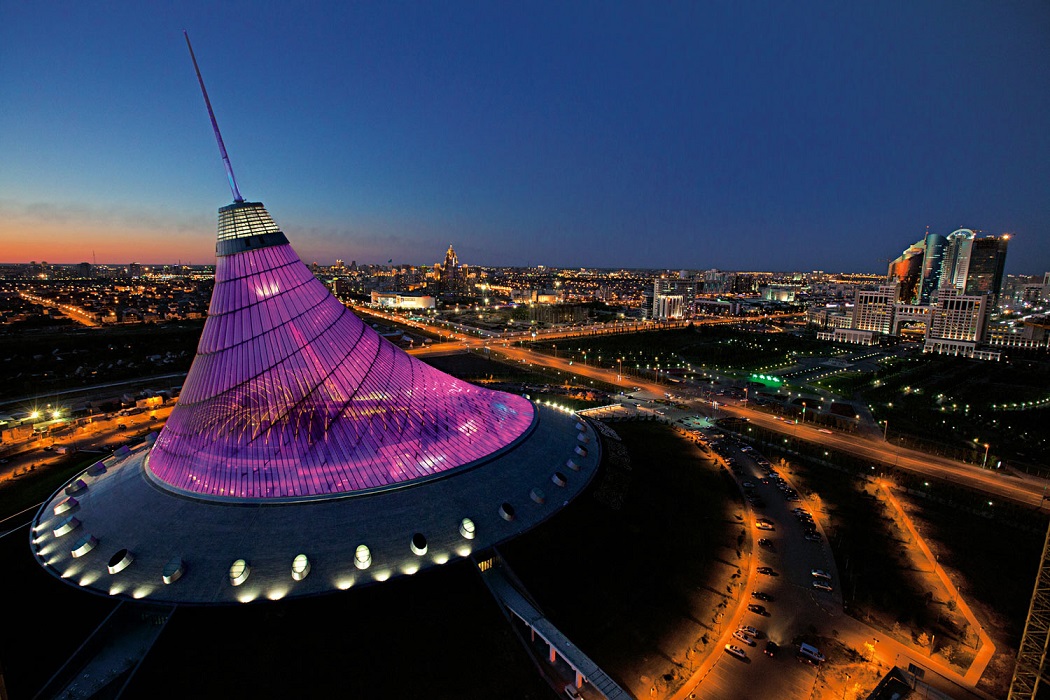With more than 100 countries showcasing their scientific know-how during what is a first for Central Asia, visitors to Kazakhstan this summer have an opportunity to explore Astana, the capital city of one of the fastest-growing economies in the Caspian region.
From June 10 – September 10, Astana is hosting Expo 2017, the region’s first world’s fair. The theme, “Future Energy,” is shedding light on 21st century ‘green’, or environmentally-friendly technologies, and illustrating that fossil-fuel rich Kazakhstan is as much concerned about the future of the planet as it is about growing the Caspian region’s third-largest economy.
Stretching between the eastern shore of the Caspian Sea and China’s western borders, Kazakhstan is home to over 18 million people. Nearly one million of them reside in Astana, a city with over 200 years of history and culture that is expected to welcome between three and four million visitors over the next three months.
When Siberian Cossacks established an outpost here in 1830, they probably did not think that their small settlement would become a capital city of an independent Turkic state, Kazakhstan. Located on the northern steppe plain, Astana is known for its sharp continental climate. Winter temperatures can drop below −50 °C (− 58 °F), while occasionally exceeding 40 °C (104 °F) in the summer. Visiting at the beginning of the summer months is ideal.
Places To See
Over the past 20 years, Astana has changed beyond recognition as new, ultra-modern buildings dot the left bank of the Ishim River, which divides the city into two parts.
Bayterek Tower, rising at a height of 105 meters, is considered a symbol of the city, which became the post-Soviet country’s capital in 1997, after being moved from Almaty. Constructed as an artistic rendition of a tree trunk with a golden sphere perched upon the top, the tower revives a legend of ancient nomads, ancestors of modern Kazakhstanis, who believed there is a Great River that flows at the junction of two worlds.

According to the nomads, there was a big tree on the bank of this river with roots holding the ground and a crown propping up the sky. Every year, the sacred bird Samruk lays an egg, symbolizing the sun, which is then swallowed by the dragon Aidahar, who lives at the base of the tree. The legend is meant to symbolize the change of summer into winter, day into night, and represents the struggle between good and evil.
Bayterek’s lower level includes cafes, aquariums and a mini-gallery. From there guests can ride up an elevator to the tower’s highest level, the golden sphere, or Samruk’s egg, inside of which there is a bar and a panoramic hall offering a 360-degree view of the city.
Khan Shatyr, meaning “royal marquee” is an impressive white building that stands on a hill in a very center of Astana and considered the largest tent in the world. Designed by British architect Lord Norman Foster and unveiled in 2006, the three-story complex features an enclosed park, luxury shopping and entertainment venues, complete with town squares and cobbled streets, a boating river, a mini-golf course and indoor beach with sand brought in from Maldives.

The pyramid-shaped Palace of Peace and Reconciliation, rising 62 meters and also designed by Foster, is another must-see. Decorated with artwork by British artist Brian Clarke, it features a stained-glass window with images of 130 pigeons that symbolize the various nationalities that call Kazakhstan home.
Astana Opera, an impressive neo-classical construction located on the western banks of Ishim River, is ranked as the third largest opera house in the world. The venue has welcomed local and foreign performers, including those representing Italy’s Teatro dell’Opera di Roma and La Scala, and Russia’s Bolshoi and Mariinsky theaters.
In addition to modern iconic landmarks, museums such as the National Museum of Kazakhstan and Astana National Art Gallery, as well as numerous mosques and lighted fountains put the city on the Caspian region’s tourist map.
Culinary Tourism
Kazakhstan’s national cuisine gives tourists another reason to visit Astana. Considered the youngest in country’s that once formed the Soviet Union, it shape today has been heavily influenced by Kazakhs transitioning over the centuries from a nomadic to a settled way of life.
Local cuisine is known for flour-based products, among which are baursaks or boortsog, small donuts made from flour, yeast, yogurt and spices. Besbarmak, chopped boiled meat with noodles and considered a “must-try,” is another delicacy, and can be prepared with four types of meat, including lamb, beef, horse meat and camel meat. To wash things down, Kumyz, a fermented, sour drink made from mare’s milk, is popular throughout Central Asia and easily found in restaurants throughout the city.
As the EXPO 2017 is underway in Astana, event organizers have prepared an extensive cultural entertainment program, including a range of culinary presentations and tastings, music concerts, exhibitions and artistic performances. The world-famous Cirque Du Soleil will present a show entitled “Reflect” throughout the summer, while the American rock band 30 Seconds to Mars will perform at a concert on July 2.







 Iran's senior military leaders described the drone and missile attack on Israel on April 14 night as “successful".
Iran's senior military leaders described the drone and missile attack on Israel on April 14 night as “successful".
 The number of evacuees from flooded areas in Kazakhstan has reached 97,852 people, including about 32,856 children since March 27.
The number of evacuees from flooded areas in Kazakhstan has reached 97,852 people, including about 32,856 children since March 27.
 Iranian President Ebrahim Raisi warned Israel that it would face a "real and extensive" response if it makes any "mistake" following Tehran’s missi...
Iranian President Ebrahim Raisi warned Israel that it would face a "real and extensive" response if it makes any "mistake" following Tehran’s missi...



